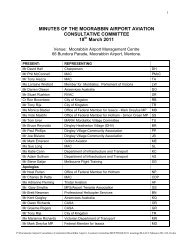Circuit Training at Moorabbin Airport Circuit Training at Moorabbin ...
Circuit Training at Moorabbin Airport Circuit Training at Moorabbin ...
Circuit Training at Moorabbin Airport Circuit Training at Moorabbin ...
Create successful ePaper yourself
Turn your PDF publications into a flip-book with our unique Google optimized e-Paper software.
“Class D” airspace is an Intern<strong>at</strong>ional Civil Avi<strong>at</strong>ion Organiz<strong>at</strong>ion (ICAO) airspace classific<strong>at</strong>ion<br />
and provides for clear and standardised airspace management with unambiguous<br />
procedures.<br />
Changes to circuit p<strong>at</strong>terns and non‐standard circuit designs <strong>at</strong> <strong>Moorabbin</strong> would in essence<br />
introduce an additional safety risk to training oper<strong>at</strong>ions and for other avi<strong>at</strong>ion users familiar<br />
with the use of “Class D” airspace procedures <strong>at</strong> similar capital city general avi<strong>at</strong>ion airports<br />
around Australia. Changes to aircraft training circuits are also likely to adversely impact on<br />
other airport users particularly helicopter oper<strong>at</strong>ions.<br />
There is also a key oper<strong>at</strong>ional training factor th<strong>at</strong> mitig<strong>at</strong>es against changes to circuit<br />
p<strong>at</strong>terns. Flying training is provided to both domestic and intern<strong>at</strong>ional students on the<br />
basis of preparing pilots to oper<strong>at</strong>e potentially domestically and intern<strong>at</strong>ionally in<br />
accordance with intern<strong>at</strong>ional standards.<br />
To introduce “special” types of circuits <strong>at</strong> <strong>Moorabbin</strong> is therefore not conducive to<br />
encouraging the development of intern<strong>at</strong>ionally consistent training by schools based <strong>at</strong> the<br />
<strong>Airport</strong>, developing skills transferable anywhere in Australia and around the world.<br />
CASA and flight training schools advised the Taskforce a circuit is designed to ensure the<br />
gre<strong>at</strong>est level of safety is achieved. Pilots are asked to perform the least amount of turns<br />
possible, as this reduces complexity and provides pilots with gre<strong>at</strong>er visibility throughout<br />
their circuit. The shape of a circuit is also determined by a standard height.<br />
Therefore MAC, noting this advice, does not support the adoption of further changes to the<br />
shape of training circuit p<strong>at</strong>terns <strong>at</strong> the airport.<br />
5.5 Helicopter <strong>Training</strong> and General Oper<strong>at</strong>ions.<br />
Similar issues to fixed wing training were also raised by community groups and local<br />
government in rel<strong>at</strong>ion to helicopter training including the scope for all of their oper<strong>at</strong>ions<br />
to be contained within the airport. While it was noted th<strong>at</strong> generally helicopter training was<br />
confined within the airport boundary there were times when training does require flying<br />
beyond the boundaries of the airport.<br />
Helicopter facilities are positioned in south central western and north western areas of the<br />
airport housing around 15 helicopters across two training schools. Helicopter training <strong>at</strong><br />
<strong>Moorabbin</strong> <strong>Airport</strong> is performed either in a circuit p<strong>at</strong>tern or undertaken on the grassed area<br />
in the south of the airfield.<br />
As a separ<strong>at</strong>ion of 300 feet is required between fixed wing aircraft and helicopters, trainee<br />
helicopter pilots must fly <strong>at</strong> a lower altitude than fixed wing circuit training aircraft.<br />
Industry and Airservices advice confirmed the p<strong>at</strong>tern of helicopter circuit training is<br />
adopted because, similar to fixed wing oper<strong>at</strong>ions, the current shape and height of the<br />
training circuit helps reduce the levels of risk in helicopter pilot training. There is little scope<br />
given the n<strong>at</strong>ure and height of these circuits to change their oper<strong>at</strong>ing p<strong>at</strong>terns without<br />
impacting on safety and overall airport oper<strong>at</strong>ions.<br />
In addition to those used for training, there are around 50 priv<strong>at</strong>ely owned helicopters based<br />
<strong>at</strong> <strong>Moorabbin</strong> <strong>Airport</strong>. There are no formal approach and departure flight p<strong>at</strong>hs determined<br />
for helicopters arriving <strong>at</strong> and leaving the airport.<br />
14




